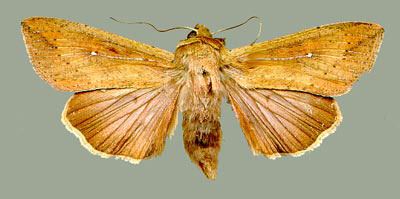2014 Armyworm Flight Is On In Kentucky
PRINCETON, KY.
Armyworm (AW) moths (Figure 1) have been captured in UK IPM pheromone
baited traps in Princeton, KY. The flight appears to be slightly, but
not significantly, delayed from previous years. The numbers captured are
not extremely large, not quite to the level of the rolling 5-year
average. However, these earlier counts may be underestimated, due to
interference by moth capture in a black-light trap located too close to
the pheromone traps. That problem has been corrected. As of this writing
the flight is tracking the 2008 out-break year though delayed about 2
weeks in time. This delay is likely mirrored in the growth stage of
wheat, and both delays are likely due to the lack of heating units in
the late winter and early spring. Our capture of AW moths this week
should give us a better idea of whether or not we are looking at a
significant AW population.

Figure 1. Armyworm moth
This time of year, AW are possible pests of small grains. Later in
the season they will also be pests of corn. Though very occasionally
found on soybeans, it is extremely rare for them to be of economic
importance on this crop. AW are also associated with cool, wet springs,
which tend to slow the germination of corn and the growth rate of wheat
and seedling corn.
We trap the AW adults (moths) to give us a heads up of what the
population size might be. The moths are migratory, coming to most of KY
from Tennessee and more southern states. The adult is the dispersing
stage and does no harm. They feed, like other moths and butterflies, on
the nectar of flowers. It is the juvenile stage or caterpillars that
cause damage by chewing on plant parts, usually leaves in the case of
wheat and corn. In most years AW caterpillars appear too late to be of
economic importance in wheat. This year will be complicated because both
the AW and our crop plants are delayed. If a cool, wet spring persists,
AW may be at an advantage. If our spring turns off sunny and warm, both
wheat and corn are likely to outgrow the threat. The only way to know
for sure what is happening is to scout for this pest.
AW caterpillars are greenish brown with a narrow mid-dorsal strip and
two orange strips on each side. The yellowish head is honeycombed with
dark lines. These caterpillars are about 1 ½” long when full grown.
In wheat, scout weekly, first checking lodge grain and field edges.
If AW caterpillars are found, then begin sampling in the standing grain.
Pick sample spots randomly. Look at the leaves for signs of chewing
damage. AW feed from the edge of the leaf towards the midrib. It is best
to scout early in the morning or late in the afternoon. AW caterpillars
are adverse to direct light and prefer moving and feeding in indirect
light. Count the number of caterpillars present in 4 square foot. If on
average, 16 larvae (½” to ¾”) are found, an insecticide treatment should
be considered.
In corn, AW is sometimes present but is rarely of economic
importance. However this is a year to be vigilant as delayed planting
and slow plant development may alter this relationship. If problems
occur, they are usually in late May to June in late planted corn. The
problem often develops as AW populations build up in small grains and as
these plants mature, AW move to young corn. This infestation may be the
classic army “marching” from small grain fields into adjacent corn
fields or it may be the more subtle situation where small grains produce
large numbers of moths that mate and fly into corn fields.
In either of these crops, larvae that are 1 ¼” long have completed
most of their feeding and do not require control. If necessary,
insecticides for control of AW in wheat may be found in ENT-47 on-line
at http://pest.ca.uky.edu/EXT/Recs/ENT47-SmallGrain.pdf, or for AW in corn in ENT-16 at http://pest.ca.uky.edu/EXT/Recs/ENT16-Field%20corn.pdf. These publications should also be available at your local county Extension office.∆
DR. DOUG JOHNSON: Extension Professor of Entomology and IPM Coordinator, University of Kentucky